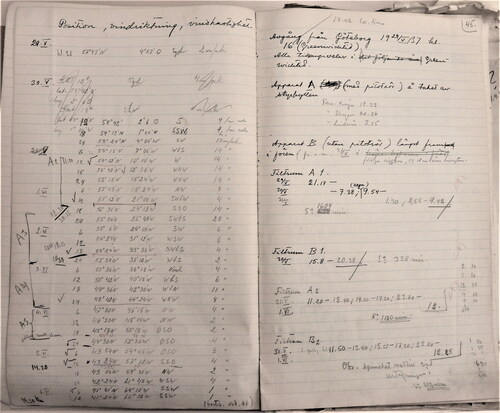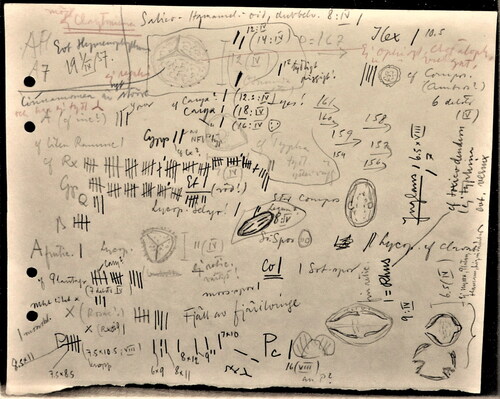Abstract
In 1937, the Swedish palynologist Gunnar Erdtman (1897–1973) mounted two adapted vacuum cleaners atop an ocean-going liner and set out to obtain air samples as he crossed the Atlantic Ocean. The devices were able to capture samples of airborne pollen which were related to air volume and distance from land. The results of this investigation are still cited in the scientific literature, but a study of publications demonstrates that the ocean study had land-based antecedents. Furthermore, archival investigation reveals the background to such studies, including the technical plans for Erdtman’s ‘aerosol collector’, records of raw data from the voyage, draft portions of the key publication, photographs and the precise location of the land-based equipment. A storage loft in the Swedish Museum of Natural History in Stockholm has been found to house a surviving aerosol collector.
1. Introduction
Upon conferment of the Medal of Scientific Excellence by the American Association of Stratigraphic Palynologists in 2003, the Norwegian palaeobotanist Svein Manum (1926–2015) responded with a series of reminiscences which included the following (Thusu and Vigran Citation2003, p. 3):
In 1954 I had the privilege of visiting Gunnar Erdtman’s newly established palynological laboratory at Bromma in Sweden. Whether a modern or fossil pollen worker, you know his legacy: the now internationally renowned palynological laboratory in Stockholm, the journal Grana, and his pioneer work on pollen morphology and plant taxonomy….Erdtman suffered from lack of recognition among Swedish academia, and particularly the top taxonomic hierarchy in Linné’s own country….One in the group of professors politely asked the young Norwegian botany student what he was doing in Sweden. When I told that I was visiting Erdtman, one of them exclaimed: "Oh, the man who vacuum cleaned the Atlantic", which caused roaring laughter from the others. Erdtman had actually "vacuum cleaned" the Atlantic. On a ship he had set up an apparatus to collect air samples to study the off shore pollen rain, and part of the apparatus was a vacuum cleaner. This was a perfectly sound scientific project, for which he received little credit.
Figure 1. Gunnar Erdtman Citation1921 (Jonsell Citation2007).
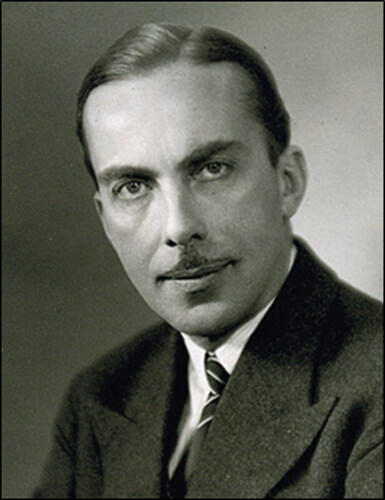
Figure 2. Front cover of Erdtman (Citation1937) offprint showing the handwritten dedication (see text for details), Naturhistoriska riksmuseet, Stockholm.
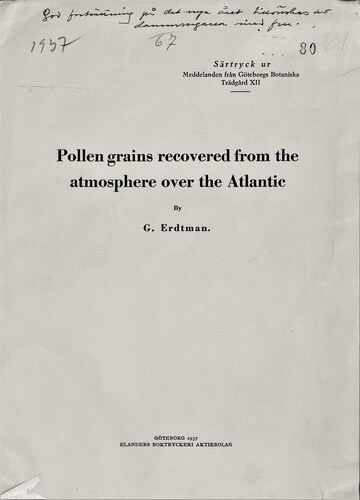
From first mentions in the late 1930s (Irmscher Citation1938; Wenner Citation1939), Erdtman’s Citation1937 paper continued to gain attention from researchers writing in the journals of such varied disciplines as palynology, biology, aerobiology, archaeology, geography, climatology, oceanography and agricultural science (e.g. Deevey Citation1944; Griffiths Citation1950; Polunin Citation1951; Hyvärinen Citation1970; Kramer et al. Citation1973; Hjelmroos Citation1991; Wolf et al. Citation2001; Giesecke et al. Citation2010; Hernandez-Ceballos Citation2014; Bajpai and Kar Citation2018), as well, most recently, in the history of biology (Charenko Citation2022).Footnote1
However, Erdtman’s use of the vacuum cleaner (Swedish ‘dammsugare’) on an Atlantic voyage had earlier or at least contemporaneous beginnings with his seemingly forgotten land-based pollen-sampling experiments. The survival of part of Erdtman’s vacuum-related pollen sampling equipment in a storage loft of the Naturhistoriska riksmuseet (The Swedish Museum of Natural History [MNH]) and archival sources at the Center for History of Science, Kungliga Vetenskapsakademien (the Royal Swedish Academy of Sciences [KVA]), both in Stockholm, Sweden have encouraged the authors to revisit Erdtman’s investigations. As such, this is also seen as a further contribution to the history of palynology and more widely to the historiography of the field, ocean and aerobiological sciences (cf. Manten Citation1966; Sarjeant Citation2002; Birks Citation2005; Edlund and Winthrop Citation2014; Riding and Dettmann Citation2014; Edwards et al. Citation2017; Birks and Berglund Citation2018; De Klerk Citation2018; Edwards Citation2018, Citation2021; Edwards and Pardoe Citation2018; Gaillard et al. Citation2018; Troels-Smith et al. Citation2018; Edwards and Mao Citation2021; Charenko Citation2022; Hooghiemstra and Richards Citation2022).
2. Gunnar Erdtman and pollen dispersal
Otto Gunnar Elias Erdtman (1897–1973) was a giant in the field of pollen and spore taxonomy and to early palynology more broadly (Erdtman Citation1943a; Fægri Citation1973; Edlund and Winthrop Citation2014; Birks and Berglund Citation2018; Edwards Citation2021). A key chemical process for the pretreatment of polleniferous samples (Erdtman Citation1934), still in use today, is known as ‘Erdtman’s acetolysis’. He was to found the journal Grana Palynologica in 1954 (Grana from 1970) and the international gold medal bestowed by the Palynological Society of India not only bears his name, but did so while he was still living (Nilsson et al. Citation1993; Edwards Citation2018). After his death, Gunnar Erdtman was referred to as ‘Mr. Pollen Analysis’ by another pioneer of the discipline (Fægri Citation1973, p. 6).
For the period 1935–1944, and certainly covering the ‘vacuum cleaner years’, Erdtman was a schoolteacher in Västerås, a city in south central Sweden located around 100 km west-northwest of Stockholm. Up until 1936, his prodigious output of publications in many areas of pollen systematics, palaeoecology and methodology (Printz-Erdtman Citation1963) should occasion no surprise that the aerial dispersal of pollen was of key interest to him. As the compiler of annual lists of pollen-related literature in the journal Geologiska Föreningen i Stockholm Förhandlingar, Erdtman would have been aware of papers that dealt with both ship- and land-based attempts to measure pollen rain (the pollen and spores falling on a site) and the characteristics of long-distance transport of pollen, as well as interest in long-travelled exotic pollen in fossiliferous deposits (Hesselman Citation1919; Erdtman Citation1921, Citation1924, Citation1936; Jessen and Rasmussen Citation1922; Malmström Citation1923; Rempe Citation1937).
3. Vacuum devices I: published statements
3.1. The Atlantic Ocean exercise
‘Pollen grains recovered from the atmosphere over the Atlantic’ (Erdtman Citation1937) was a record of Gunnar Erdtman’s experiment to assess wind-transported pollen over long distances. With the support of Carl Johan Fredrik Skottsberg (1880–1963), Professor and Director of the Göteborgs botaniska trädgård (Gothenburg Botanical Garden), Erdtman secured passageFootnote2 and assistance on a voyage of the Swedish American Line vessel SS Drottningholm () from Gothenberg to New York in May-June 1937. The Drottningholm (= Queen’s Isle) was one of the earliest steam turbine ocean liners and had been built in Glasgow in 1904 and named the RMS Virginian. It saw service in World War I as a British troopship and armed merchantman (Reimertz Citation2018). In addition to passage on the liner,Footnote3 Erdtman also received contributions of two vacuum cleaners and a manometer from the Lux company, a founding constituent of Electrolux ABFootnote4, and an electric centrifuge from Rudolph Grave AB, both of Stockholm.
Figure 3. SS Drottningholm in New York (Public domain, Wikipedia). The hull was repainted white in 1937, the year of Erdtman’s voyage.
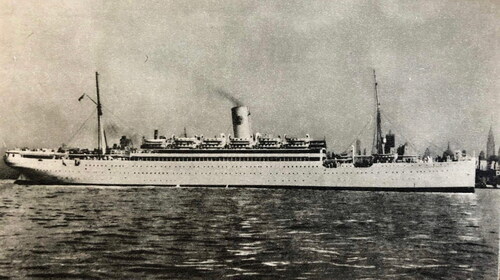
Two vacuum cleaners (Electrolux model Z25 [not 225 as stated by Erdtman] powered at 110 V DC; Supplementary material, Figure 1) were used simultaneously on board the ship. One was fastened on top of the bridge ∼18 m above sea level with the air inlet pointed forwards, and the other was fastened in the stern rigging (or fore rigging or foremast according to Erdtman Citation1938a,Citationb) at a similar height with the air inlet directed obliquely upwards. Filter paper took the place of the dust bag and Erdtman seemed to have garnered this idea from knowledge of the vacuum-based dust extraction techniques of the famous Swedish forensic scientist Harry Söderman (cited in Erdtman Citation1937, p. 190 and cf. Erdtman Citation1938a, p. 352, though the idea was not that of Erdtman [see below]). A pitot tube fitted to the vacuum exhaust, in combination with a manometer (pressure gauge) was used to calculate the air flow velocity. Filter bag dissolution and pollen concentration took place back in Erdtman’s Västerås laboratory and involved two acetolysis (acetic anhydride, glacial acetic acid, sulphuric acid) treatments, silicon removal with hydrofluoric acid, and centrifugation. A cautionary note, well understood from later health and safety regimes, was sounded when Erdtman (Citation1937, p. 192) observed that ‘during the reaction, vapours causing eye pain, are produced; the whole operation, therefore, should be made in a [fume] hood’. Pollen concentrates were embedded in glycerine or glycerine jelly and suspensions were viewed microscopically after transfer to a counting chamber (cf. Erdtman Citation1935). Technical explanations are described in the paper, and the arrangement of the devices, albeit within a land-based metal housing, are shown below.
The choice of publication outlet for the 1937 paper – Meddelanden från Göteborgs Botaniska Trädgård – was likely connected with Skottsberg’s assistance and his Directorship of the Gothenburg Botanical Garden. The results of the ocean study were also published in summary form in several of Erdtman’s later contributions (e.g. Erdtman Citation1938a, Citation1943a, Citation1945) and the principal areas of relevance to the current paper may be listed as:
The vacuum cleaner experiments took place 29 May-7 June 1937 (westward journey) and 9–19 June (eastward) ().
Only data from the westward voyage from Gothenburg to New York were reported in detail as those from the return journey were ‘disappointing’ and ‘not worth recording’ owing to the advanced season and bad weather, including northerly winds (such winds, passing over sea rather than land, would not be strongly pollen-bearing).
During rain or dense fog, the ship-borne equipment was turned off and protected.
The data ( and , and described in Erdtman [Citation1937]) showed that the mean number of pollen grains sampled per 100 m3 of air was 6.6 (range 0.7–18.0 with lower values over mid-ocean, up to 660 km from the nearest land, and highest values closer to land).
These contrast with the ∼18,000 grains/100 m3 obtained 1 April-1 June 1937 from an experiment on the top of the water tower in Västerås.
The results from the voyage may have seemed scanty, but the aim was to quantify airborne pollen content over oceans.
Biologically and meteorologically, Erdtman thought it would be useful to establish land-based aerosol collectors or vacuum cleaners in heavy metal cases at fixed points in Greenland and the Faroe Islands, for instance, to establish the atmospheric drift of palynomorphs.
Figure 4. Top: the westward journey of Drottningholm in 1937 showing sampling information as published in the 1937 paper. The original caption reads: ‘ – Map of the route followed. With the dates, the direction and velocity of the wind at every sixth hour, the number of the filterbags exposed (Roman figures) and the distance from nearest land (in kilometers). Filled track: vacuum cleaners operated; open track: vacuum cleaners not in operation.’ Bottom: The annotated working map for both outward and homeward voyages of the Drottningholm, along with weather conditions for the westward journey, made on the original route map as supplied by the shipping company. The cabin type (‘Cabin Vestibul.’) is indicated in the top left of the map (KVA).
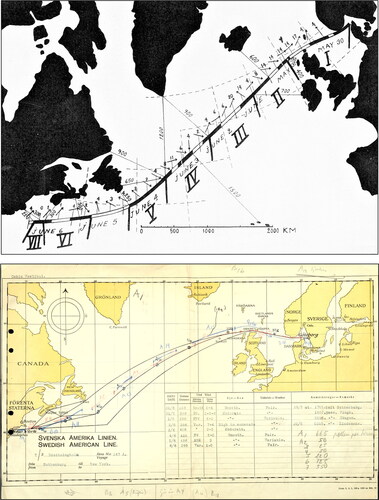
Figure 5. The data table from Erdtman (Citation1937). The figures in bold depict substantial pollen counts for the respective taxa.
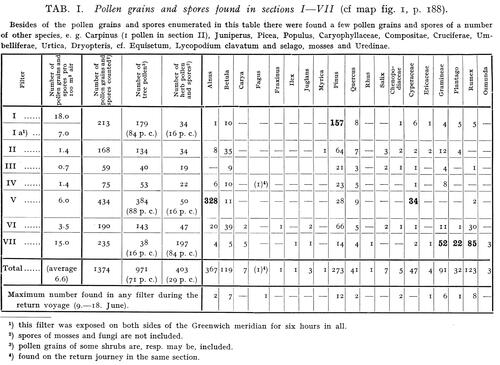
3.2. The land-based/water tower experiments
Mention had been made to land-based studies of aerosol content at the very start of the 1937 paper (p. 185):
During parts of 1936 and 1937 some investigations of the pollen content of the air in a densely forested part of Central Sweden were conducted by means of vacuum cleaners….The experiments were chiefly undertaken to obtain reliable material for studying some of the theoretical foundations of pollen analysis. Complementary to these investigations it was decided to calculate the amount of pollen grains carried by the winds over very great distances, e.g. across wide sheets of water such as the northern part of the Atlantic.
Figure 6. The water tower (Vattentornet) in Västerås (https://commons.wikimedia.org/wiki/File:Vattentornet_Dj%C3%A4kneberget_V%C3%A4ster%C3%A5s.jpg; public domain).

Table 1. Dates for the oceanic and land-based vacuum experiments.
Similar tests were carried out on the water tower in Västerås (approx. 70 metres above sea level) from April 1 to June 1 of the same year [1937] with an ‘aerosol collector’, for which the Lux company in Stockholm produced the drawings according to the director’s [i.e. Erdtman’s] instructions. Among other things, pollen from….trees and shrubs was collected….On a filter in a vacuum cleaner, which was in operation from Christmas Eve 1936 to New Year’s Day 1937, the most important of the types of pollen occurring in peatlands, including Tilia, were obtained. In addition, a number of the large and easily identifiable pollen grains of Zea were found. The ground was not covered with snow at the time, and most of the captured pollen grains must have been swirled up with the dust from roofs, streets, fields, etc. (about ten individuals of Zea bloomed in the fall of 1936 in the school garden about a hundred meters from the place where the vacuum cleaner was set up….)
In 1943 when his book Introduction to Pollen Analysis appeared (Erdtman Citation1943a), two chapters (13 – ‘Output and dissemination of pollen’ and 14 – ‘Surface samples’) included discussion of long-distance pollen dispersal. Of interest is that each of the chapters mentioned the research related to vacuum cleaners. The first of these incorporated a summary of his 1937 paper, while the second mentioned an ‘aerosole collector’ (p. 188). The latter has a particular bearing here and selected sections are quoted (ibid. pp. 187–188):
In order to obtain a tolerably objective idea of the composition of the pollen rain settling, e.g. on the surface of a bog, it would be necessary to investigate the pollen sedimentation of a large number of sample areas. Another method, tried tentatively by the author, is based on the assumption that the composition and amount of pollen sediment in a certain area is proportionate to the composition and amount of pollen grains in the air above the area in question. By trapping the pollen grains by means of vacuum cleaners, it would be possible to record continuously the pollen flora per cubic meter of the air. Uninterrupted drift is secured by enclosing the vacuum cleaners in special cases made from iron plate to prevent any interference from rain and larger objects such as leaves, insects, etc. The vacuum cleaner is placed vertically within the casing with the inlet upwards and the outlet downwards. The amount of air sucked through per minute is calculated by means of a manometer installed in a box attached to the casing. The whole apparatus, or ‘aerosole collector’, is about 150 cm high, its weight about 70 kg. It is fastened to a heavy concrete square holding it in position even in high winds. If the motor in a vacuum cleaner is worked continuously for weeks it must be overhauled, or even exchanged, once a month. The atmospheric dust is trapped in bags of filter paper, which are later chemically dissolved and treated….Each bag is exposed for 24 hours, or for a somewhat longer or shorter period, according to the circumstances….
In a paper which appeared two years later, Erdtman (Citation1945) recorded (p. 132):
In Västerås, during the period 1 April-1 July 1937, an orientational aerobiological investigation was carried out, whereby the airborne content of pollen grains and spores was determined with the help of an ‘aerosol collector’ installed on the city’s water tower. A continuously working vacuum cleaner, which on average filtered around one cubic metre of air per minute, served as an aerosol collector. The vacuum cleaner was mounted so that it could work regardless of changes in the weather. Due to a lack of time, the experiment could not be continued.
In the same year, Roger Philip Wodehouse (1889–1978), the Canadian-American botanist and aerobiologist, and a correspondent of Erdtman’s, published the first edition of his book Hayfever Plants (Wodehouse Citation1945)Footnote5 in which he referred to the ‘Erdtman Air Filtration Method’ using the ‘Aerosol Collector’ (ibid. pp. 9–10). This was illustrated with the diagram of the latter (vacuum cleaner, pitot tube and manometer) from Erdtman (Citation1937; and see KVA archival data section below) together with mention of the pollen counting chamber cited above.
4. Vacuum devices II: archival data
4.1. Museum photographs
The photographic album of Erdtman’s Palynological Laboratory, held in the archive of the Swedish Museum of Natural History, contains pictures (; Supplementary material, Figure 2) that were probably taken on the same occasion. In , Erdtman is stood before the ‘aerosol collector’ discussed above. His hands rest upon the vacuum cleaner standing vertically within the equipment housing, while the manometer rests upon a shelf at the front of the housing. , although labelled ‘G. Erdtman Västerås (about 1940)’ in the album, is more precisely labelled ‘Jmf. [jämför = compare] 27 [or overwritten 26] October 1937’, along with the words ‘aerosoluppsamlaren på vat[tentornet]….’ (= the aerosol collector on the wat[er tower]) on the reverse. The walling shown in and Supplementary material, Figure 2, together with another photograph taken in 1935 (), along with the tall church spire in the background of the pictures, identifies this as top of the water tower shown in . The sampling equipment together with a centrifuge is spread upon a work bench in another photograph (). The October 1937 date for at least one of the photographs may indicate that the equipment was used for a longer period than indicated in the publications (), unless the later date denotes photography after the apparatus was no longer in use.
Figure 7. (A and B) Gunnar Erdtman, Citation1937, and the ‘aerosol collector’ vacuum equipment with manometer (MNH); (C) Water tower roof, 1935, photo by Ernst Blom, ‘Vattentornet vid Djäkneberget, Västerås’ (https://digitaltmuseum.se/0210110486166/vattentornet-vid-djakneberget-vasteras. ; public domain); (D) Erdtman, Citation1937, showing the manometer, vacuum cleaner and centrifuge on the laboratory bench (MNH).
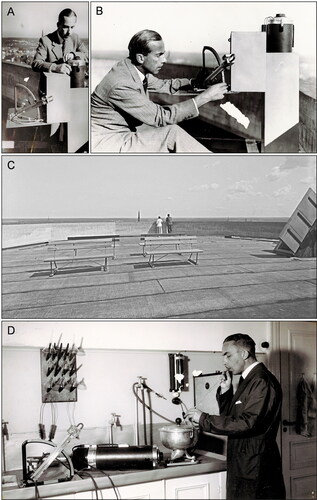
4.2. MNH documentary archive
A storage boxFootnote6 in the museum contains a folder marked ‘Dammsugning [= vacuuming] Västerås 1937’, which further contains a labelled notebook. This is covered in black ink or paint lines, squiggles, and thick brush strokes () which are often found in Erdtman’s documents, though usually with more delicacy and are sometimes multi-coloured (Edlund and Winthrop Citation2014; Edwards and Pardoe Citation2018). The label is headed by his characteristic signature (including the ‘mouse-ear’ initial letter G [for Gunnar]) and describes its contents.
Figure 8. Cover of the Atlantic voyage data notebook (MNH). The cover is labelled as follows (see text for further details): Erdtman (Citation1937), Materialuppgifter (= Material data), Antalet pollen i div. blommor (= The number of pollen in var.[ious] flowers), Upplösning av filtrerpapper (= Dissolving the filter paper), Resa Göteborg – New York (= Travel Gothenborg – New York).
![Figure 8. Cover of the Atlantic voyage data notebook (MNH). The cover is labelled as follows (see text for further details): Erdtman (Citation1937), Materialuppgifter (= Material data), Antalet pollen i div. blommor (= The number of pollen in var.[ious] flowers), Upplösning av filtrerpapper (= Dissolving the filter paper), Resa Göteborg – New York (= Travel Gothenborg – New York).](/cms/asset/efba8f28-0b6c-43d1-bd43-d83e0e3fc169/tpal_a_2260437_f0008_c.jpg)
The 49 pages of data primarily relate to the Atlantic voyage along with estimates of pollen productivity for four taxa (Betula pubescens, Quercus robur, Carpinus betulus and Picea excelsaFootnote7). The ship-board data include recurrent types of material of which examples are shown in . Data and textual comments include those for: equipment dimensions and suppliers; chemical treatments; geographical coordinates, wind speeds and directions; times expressed in Greenwich Mean Time; filter paper sample indices and visual states of the filters – ‘sönder’ (broken), ‘smutsig’ (dirty), genomblött (soaked through), ‘saknas’ (missing); and manometer readings for apparatus A (the vacuum cleaner ‘[p]å taket av styrhytten’ [on the roof of the wheel house]) as opposed to readings for Apparatus B (the vacuum cleaner ‘längst fram i fören’ [at the front of the bow]).Footnote8
In addition to the foregoing, there are portions of a draft of the paper which was to appear as that in Meddelanden från Göteborgs Botaniska Trädgård (Erdtman Citation1937). The draft is written in a mixture of Swedish and English and the material that survives adheres closely to the final published version ().
Figure 10. A sample page of the draft of the 1937 paper contained in the Atlantic voyage data notebook, illustrating the pollen counting chamber for determining estimates of the absolute numbers of pollen grains and spores per 100 m3. The diagram is described but did not appear in Erdtman (Citation1937) (MNH).

4.3. Letters from Lux AB in the KVA archive
In parallel with an examination of the Erdtman holdings within the museum, Erdtman’s correspondence archive at the Center for History of Science of the Royal Swedish Academy of Sciences contains material relevant to his vacuum devices.Footnote9 Erdtman was in contact with the Lux company since at least the beginning of 1936. On 22 January of that year, he had written a letter to the company concerning the use of vacuum cleaners for pollen collection. The response of 28 January 1936, signed by a Josef Junberger [?] from the Lux laboratory survives (Supplementary material, Figure 3). Erdtman had clearly asked about the voltage requirements of the equipment, and he was informed that the lowest voltage for which a standard vacuum cleaner was manufactured had been 22 volts and that it was not therefore possible to operate the cleaner with a car or motorcycle battery. For this purpose he would need to use a specially prepared accumulator battery operating at 250 watts with a maximum amperage load on the discharge current of 15 amperes. It was advised that for the experiments in question, it may be important that the device should be able to draw a maximum of about 1 m3 of air per minute through the vacuum cleaner. In addition, Erdtman was warned that it would not be possible to use the usual dust bag of the vacuum cleaner, but that he should employ a dust bag made of filter paper (‘white or black, depending on the colour of the pollen’). The helpful correspondent suggested that such a paper filter bag could be similar to that described in an attached, but not archived, offprint from Nordisk kriminalteknisk tidskrift 1931 (Söderman Citation1931; discussed above).
A second letter connected with the vacuum cleaner was sent by an Ernst Fredlund of the Lux Company to Erdtman on 22 September 1939. Headed ‘aerosol collector’ (Supplementary material, Figure 4), it is largely a house-keeping document detailing equipment loans between Erdtman, Lux, and a Dr Oddvar Andrup of Oslo. The loans included a 220 V vacuum cleaner, a pitot tube, a manometer and accessories. The letter confirmed that Erdtman, as outlined in a letter of his dated 14 May, currently had a vacuum cleaner for which Lux would appreciate its return ‘for the sake of order’, unless it was still required.
There is no indication that Erdtman wished to retain the equipment for terrestrial experiments. Of interest, however, is the final paragraph of the 22 September letter:
Regarding your planned surveys of the pollen frequency at different heights above the earth’s surface with the help of vacuum cleaners, suitably mounted on aircraft, we believe that these surveys are technically possible to carry out. We are ready to be of service with information on this point and we hope that external conditions will soon be such that your planned investigation can be carried out.
4.4. Plans
The technical drawing produced by the Lux company for the ‘aerosol collector’ (Erdtman Citation1938b) is archived at the KVA. The Aerosoluppsamlare (= aerosol collector) plan is dated 10 March 1937 () – though the emboldened number 7 in the date appears to over-write a 6 (Supplementary material, Figure 5). A date of 1936 would make more sense in that it would allow time for the equipment to be constructed ready for the Västerås water tower tests beginning 24 December 1936. The change in the plan date from 1936 to 1937 may be an archival relict by thoseFootnote10 who collated Erdtman’s papers after his death and in an effort to incorrectly associate the plans for the land-based aerosol collector with documents relating to the Atlantic voyage.
Figure 11. The Aerosoluppsamlare (= aerosol collector) plan dated 10 March 1937, though the ‘7’ overwrites a ‘6’; an earlier date would seem more logical (see text and see Supplementary material, Figure 5) (KVA).
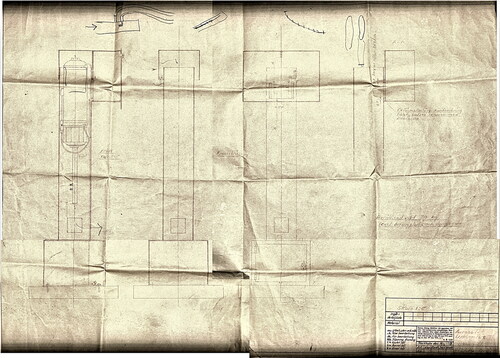
The plan is a relatively sparse drawing at a scale of 1:5 and shows the metal housing in three elevations with the vacuum cleaner cylinder and pitot tube in position. There are few words on the plan, but they include ‘kabel’ (= cable), ‘svetsas’ (to be welded) and ‘Beräknad vikt 70 kg (excl. betongplatta och dammsugare)’ (= Estimated weight 70 kg [excluding concrete slab and vacuum cleaner]). There is a pencilled marginal sketch depicting the pitot tube connection to the manometer, as well as additional plans showing the same more formally (Supplementary material, Figure 6). An arrow indicates the mains electrical cable exiting an access cavity at the base.
4.5. Map
The map in Erdtman’s Atlantic publication showed the westward voyage of the Drottningholm, with aerosol collections over 8 days (I-VIII in ). A working map, with various annotations (e.g. denoting the forward or rear vacuum cleaner readings for both legs of the voyage and weather conditions), utilized the original route map as supplied by the shipping company ().
4.6. Additional documentation
There are several pages of torn-off notepaper containing a mixture of pollen counts, drawings of pollen grains, geographical coordinates and references to samples of filter paper (cf. ) from the Atlantic journey.Footnote11 In addition, a folder labelled ‘Väderleksuppgifter’ (= Weather information) contains newspaper cuttings of meteorological conditions immediately prior to the voyage (Supplementary material, Figure 7).
4.7. Letters in response to the publication of Erdtman (Citation1937)
A series of letters relating to Erdtman’s Citation1937 paper, the equipment and replication of the methodology are to be found in the KVA archive.Footnote12 On 19 September 1937, Erdtman wrote to the British archaeologist James Burchell,Footnote13 providing pollen counts and adding:
My wife and I went to New York early in June studying the absolute content of pollen grains in the atmosphere all the way across by means of vacuum cleaners. I am writing a short note on our results (about a dozen pages when printed). May I send it on to you, when ready, for the necessary corrections?
Three of Erdtman’s international (and ultimately distinguished) correspondents were impressed by his vacuum-based Atlantic investigation. Lucy May Cranwell (1907–2000), the New Zealand botanist and newly initiated palynologist (Cranwell and von Post Citation1936), wrote to Erdtman from the Auckland Museum on 4 March 1938, thanking him for receipt of the ‘Trans-Atlantic’ paper and expressing a wish that ‘we could get something of the kind done between Australia and New Zealand, or even between New Zealand and the Chatham Islands’.
On 18 May 1938, the Indian palaeobotanist Birbal Sahni (1891–1949), of Lucknow University, but writing from Vienna, told Erdtman that the Atlantic Ocean paper ‘impressed me so much that I wish to use the opportunity of my homeward voyage for a similar investigation….[across] the Arabian Sea’, hopefully borrowing Erdtman’s apparatus for the purpose. Erdtman responded from Västerås on 22 May 1938, telling Sahni that he had ‘written to the Electro-Lux Company and I think that they will be glad to place a vacuum-cleaner at your disposal’. Furthermore, he hoped that Sahni would visit him in Sweden in order that the use of the equipment can be demonstrated. Two more letters from Sahni survive in the archive, sent 29 May and 2 July 1938, and indicated that the health of his wife prevented a visit to Sweden, but that he was seeking advice on the nature of the electrical supply and the type of fuel burned by the potential ships. Coal and oil were both likely to emit smoke and Erdtman had probably informed Sahni of the difficulties when attempting to isolate the pollen grains adhering to the vacuum filter papers.
There seems to be no evidence from either letters or publications that either Cranwell or Sahni in particular, followed-up on the interest expressed in their correspondence. Letters between Gunnar Erdtman and Roger Wodehouse spanning 1937 and 1938 are of a slightly different nature and relate essentially to terrestrial, airborne entities rather than long-distance transport of pollen and spores over large stretches of sea. Wodehouse clearly had knowledge of Erdtman’s voyage as, on 20 September 1937, he wrote to Erdtman from his home in Yonkers, New York state, enquiring of the experiments:
I was very much impressed with your apparatus. It seems to me to be perfect and it should replace all other methods. We have recently organized a “Committee for the Study of Atmospheric Pathogens and allergens”, sponsored by the National Research Council….I would like very much to introduce your apparatus at that meeting, and see if we can get a number of them operating in various places, and a central laboratory established at Washington to which the collections could be sent for analysis.
5. Museum equipment
Discussion between the authors concerning the physical remnants of Erdtman’s laboratory at the MNH revealed that some apparatus resided in the museum’s storage loft. Upon inspection, this was clearly intended to contain electrical equipment and it was identifiable from the photographs as being the housing associated with the land-based aerosol collector. Indeed, as mentioned above, the back of displays the words ‘aerosoluppsamlaren på vat[tentornet]….’ (= the aerosol collector on the wat[er tower]).
The equipment is here described in conjunction with the gallery of photographs presented in and in Supplementary material, Figures 8–19. The iron-plated apparatus is certainly heavy and reaches a height of 153 cm (). The vacuum cleaner fitted inside a metal box, with a hinged lid, which lies in the same plane as the stem of the equipment (cf. and Supplementary material, Figures 12–16). The vacuum cleaner cylinder rested upon two metal brackets screwed to the equipment housing () and presumably received its power from its own supply cable as there is no indication of splicing of the thick cable which runs through the length of the apparatus and for which the plug would exit through one of the four basal rectangular holes (). A lamp (most likely for recording manometer readings in the dark) was fixed to the metal box bolted to the stem and it received its electrical supply via a Luma transformer connected to the mains cable () which was doubtless intended to step-down the mains input voltage to the rated voltage of the lamp. A hinged flap on the box opened downwards and formed a level surface upon which the manometer was placed ( and cf. ). The compartment at the base of the equipment contained several blank forms which may have been intended for recording such details as manometer readings and meteorological and floristic observations (Supplementary material, Figure 8).
Figure 13. Erdtman’s aerosol equipment in the loft of the Naturhistoriska riksmuseet, Stockholm: A. Front elevation showing the hinged flap which acts as a support for the manometer when open and the open compartment at the base containing data recording forms (equipment height 153 cm); B. Vacuum cleaner housing; C. Power cable and plug; D. Lamp bulb holder and voltage transformer (MNH).
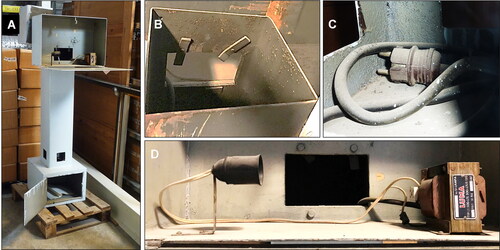
6. Conclusions
Svein Manum’s reminiscences which opened this paper were correct in musing that Erdtman had received little credit for his oceanic studies in pollen transport – at least amongst plant taxonomists. His work has been shown to have longevity, however, and the 1937 article is an acknowledged milestone in the methodological development of palynology. His trans-Atlantic pollen rain experiment may have garnered the immediate interest of palynologists and the steady attention of later commentators, yet an examination of the published literature demonstrates that there were antecedent terrestrial investigations by the Swede. Archival research throws an enriching light on aspects of the development of both Erdtman’s land-based aerosol collector, as well as the temporal and spatial extension exemplified in ‘vacuum cleaning the Atlantic’. It has always been appreciated that the ubiquity of airborne pollen and spores does not signify an unchanging atmospheric component, but Erdtman’s efforts were aimed at cementing the dynamic nature of palynologically-based aerial plankton, with quantitative estimates of its character.
The archival material reveals the importance to Erdtman of seeking support from equipment manufacturers and the shipping line, as well, perhaps, of an obligation to publish in the Gothenburg journal of Carl Skottsberg whose ministrations had secured passage for Erdtman (and his wife) on the Drottningholm. Erdtman was not a wealthy teacher, and he did not become a wealthy researcher. In fact, other letters reveal that much of his time was spent in fighting for funds (Fægri Citation1973; Edlund and Winthrop Citation2014; Edwards Citation2021) and for the acceptance of his science in an educational system where established disciplines and powerful professors held sway (Fægri Citation1973; Sarjeant Citation1973).
The letters interestingly show the source of the filter paper idea adopted by Erdtman came from a laboratory employee of the Lux Company, while the outbreak of war thwarted a plan to extend the experiments to aircraft-mounted vacuum devices. The unpublished documents reflect the difficulties of experimentation, exemplified by notes describing filter papers as broken, missing, dirty, and sodden. The draft of portions of the Atlantic Ocean article, with its mixture of Swedish and English text, is entirely in keeping with Erdtman’s multi-lingual facility as discussed elsewhere (Edwards Citation2021). This did not stop him from seeking help from James Burchell where appropriate.
The ‘messiness’ of the pollen count sheets, with statistical calculations and drawings of probable unidentified pollen grains, along with the doodled ink or paint lines, reflect another side of Erdtman – indeed, apart from being a meticulous scientist, he was also a fine draftsperson and artist; his father, Elias Erdtman (1863–1945), was a professional landscape artist in his own right.
The photographs in the laboratory photo album of the Natural History Museum vividly bring Erdtman’s pre-Atlantic efforts to life. Importantly, the existence of the photographs has enabled us to pinpoint the precise location of his terrestrial experiments in Västerås. This is reinforced by the survival of his land based ‘aerosol collector’ which resides in the loft of the museum. The metal housing is a piece of scientific apparatus – part of the intellectual archaeology and heritage of the discipline of palynology and one that is tied intimately to a remarkable pioneer of pollen studies.
Supplementary Material - Palynology paper, KJE.docx
Download MS Word (24 MB)Acknowledgements
It is a pleasure to acknowledge the archival assistance provided by the Center for History of Science, The Royal Swedish Academy of Sciences and by Maria Asp in particular. The Center and the Palynologiska laboratoriet, Naturhistoriska riksmuseet are both thanked for permission to reproduce images used in this paper and in the associated online Supplementary files. The authors are grateful to Tony Hooley for his advice concerning the electrical components of the aerosol collector and Malin Eriksson of the Electrolux Company for historical guidance. The sharing of personal reminiscences of the Palynological Laboratory by Elisabeth Grafström is much appreciated.
Disclosure statement
No potential conflict of interest was reported by the authors.
Data availability statement
The locations of archival data are indicated in the text.
Additional information
Notes on contributors

Kevin J. Edwards
Kevin J. Edwards holds degrees from the Universities of St Andrews (MA, DSc) and Aberdeen (PhD). He is Emeritus Professor in physical geography and adjunct chair in archaeology in the University of Aberdeen, adjunct professor in the Graduate Center, City University of New York, and, at the University of Cambridge, Fellow Commoner of Clare Hall, Senior Fellow of the McDonald Institute for Archaeological Research and Emeritus Associate of the Scott Polar Research Institute. He has held academic posts and visiting research positions in a number of universities including those of Queen’s Belfast, Birmingham, Sheffield, Minnesota, Copenhagen and Oxford. A palynologist with a strong involvement in multidisciplinary Quaternary science, his interests include human-environment interactions during Lateglacial and Holocene times in Britain and Ireland, Norse impacts upon the landscapes of the North Atlantic region, methodology, and the history of science.
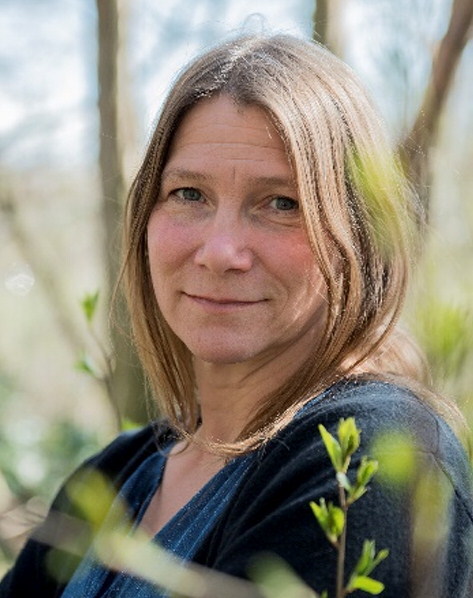
Pia Östensson
Pia Östensson is curator of the Palynological Laboratory in the Department of Environmental Research and Monitoring of the Naturhistoriska riksmuseet (Swedish Museum of Natural History) in Stockholm. A graduate in biology (plant systematics) from Stockholm University, she administers the pollen monitoring network for central Sweden and has extensive experience of aerobiology and forecasting based on airborne pollen sampling, plant phenology, and long distance palynomorph transport. Her previous posts have included the teaching of floristics at Stockholm University, scientific consultancy, and senior assistant of collections for the Linnean herbarium in the Department of Phanerogamic Botany in the Naturhistoriska riksmuseet. She was the botanist and illustrator for the book System och passion: Linné och drömmen om Naturens ordning.
Notes
1 According to data extracted from Google Scholar (Citation2022), the paper has received 89 citations, excluding self-citation, over a period of 85 years. Although its average of a single citation per annum may be thought unremarkable, it clearly has a longevity that is unusual in science This may be shown for the period 1970–2018, where the average lifespan of a paper is greatest in its third year of life after which it decreases progressively, and few papers are cited beyond 20 years (based on 4.50 M citable documents, including 3.85 M articles, 8.51 M citations and 27 subjects; Mendoza Citation2021).
2 A letter from Erdtman to the British archaeologist James Burchell written in 1937 (see below) stated that the Swede was accompanied by his wife (Gunborg [‘Gunni’] Erdtman [née Printz; 1904–1993]) who often accompanied him on visits abroad (Nilsson and Praglowski Citation2000; Edwards and Mao Citation2021).
3 Erdtman seemed to have passage in ‘Cabin Vestibul’ (). The ship had berths for 280 cabin class, 300 second class and 700 third class passengers (New York Times Citation1920). The notorious rolling in heavy seas gave rise to the vessel’s nickname of ‘Rollingholm’ or ‘Rollinghome’ (Reimertz Citation2018).
4 AB is an abbreviation of Aktiebolaget (= limited company).
5 This was published in the same series (‘New Series of Plant Science Books’, edited by Dutch-American botanist Frans Verdoorn [1906–1984]) as Erdtman (Citation1943a). Indeed, Wodehouse provided the foreword to the Swede’s volume. Wodehouse had published one of the few books devoted to pollen grains prior to the appearance of Erdtman’s Introduction (Wodehouse Citation1935).
6 MFÖ, Palynologiska lab. 26.
7 The name is no longer accepted. The current name is Picea abies: https://www.itis.gov/servlet/SingleRpt/SingleRpt?search_topic=TSN&search_value=194775#null [accessed 7 February 2023].
8 It is difficult to reconcile fully the location for vacuum cleaner B with the published one of being fastened in the stern rigging (Erdtman Citation1937) or fore rigging or foremast according to Erdtman (Citation1938a,Citationb). Apparatus A clearly refers to the vacuum cleaner located on top of the bridge (Erdtman Citation1937).
9 Most of the material is held within KVA archive Gunnar Erdtman, Handlingar rörande experiment och forskning på fältet 1935–1937, F01:4.
10 Elisabeth Grafström, Erdtman’s former assistant, said that his papers had been collected, ordered and distributed to the KVA and the MNH by herself and the late Siwert Nilsson, a successor to Erdtman as Director of the Palynological Laboratory (personal communication, 1 May 2023).
11 KVA archive Gunnar Erdtman, Handlingar rörande experiment och forskning på fältet 1935–1937, F01:4.
12 KVA archive Gunnar Erdtman, Inkommande brev 1933–1947, E1:5 and Utgående brev 1930–1939, B1:1.
13 James Percy Tufnell Burchell (1898–1979), then a tax assessor living in the Hyde Park area of London, England, who was involved with the investigation of many Palaeolithic sites in Eastern England and Ireland.
References
- Bajpai R, Kar R. 2018. Modern pollen deposition in glacial settings in the Himalaya (India): abundance of Pinus pollen and its significance. Palynology. 42(4):475–482.
- Birks HJB. 2005. Fifty years of Quaternary pollen analysis in Fennoscandia 1954–2004. Grana. 44(1):1–22.
- Birks HJB, Berglund BE. 2018. One hundred years of Quaternary pollen analysis 1916-2016. Vegetation History and Archaeobotany. 27(2):271–309.
- Charenko M. 2022. Blowing in the wind: pollen’s mobility as a challenge to measuring climate by proxy, 1916–1939. Journal of the History of Biology. 55(3):465–493.
- Coons GH. 1936. Improvement of the sugar beet. United States Department of Agriculture Yearbook 1936, Washington D.C. p. 625–650.
- Cranwell LM, von Post L. 1936. Post-Pleistocene pollen diagrams from the Southern Hemisphere: I, New Zealand. Geografiska Annaler. 18(3-4):308–347.
- Damialis A, Kaimakamis E, Konoglou M, Akritidis I, Traidl-Hoffmann C, Gioulekas D. 2017. Estimating the abundance of airborne pollen and fungal spores at variable elevations using an aircraft: how high can they fly? Scientific Reports. 7(1):44535.
- Deevey ES. 1944. Pollen analysis and Mexican archaeology: an attempt to apply the method. American Antiquity. 10(2):135–149.
- De Klerk P. 2018. The roots of pollen analysis: the road to Lennart von Post. Vegetation History and Archaeobotany. 27(2):393–409.
- Edlund AF, Winthrop ZA. 2014. Sharing what he saw: an appreciation of Gunnar Erdtman’s life and illustrations. Grana. 53(1):1–21.
- Edwards KJ. 2018. Pollen, women, war and other things: reflections on the history of palynology. Vegetation History and Archaeobotany. 27(2):319–335.
- Edwards KJ. 2021. Marginalia in the ‘bible’ of pollen analysis: Gunnar Erdtman and the annotations of a displeased ‘evangelist’. Review of Palaeobotany and Palynology. 295:104538.
- Edwards KJ, Fyfe RM, Jackson ST. 2017. The first 100 years of pollen analysis. Nature Plants. 3(2):17001.
- Edwards KJ, Mao L. 2021. William Su Ting – China’s forgotten palynologist. Palynology. 45(3):391–419.
- Edwards KJ, Pardoe HS. 2018. How palynology could have been paepalology: the naming of a discipline. Palynology. 42(1):4–19.
- Erdtman G. 1921. Pollenanalytische Untersuchungen von Torfmooren und marinen Sedimenten in Südwest-Schweden. Arkiv För Botanik. 17(10):1–173.
- Erdtman G. 1924. Studies in micro-palaeontology IV. Peat from the Chatham Islands and the Otago district, New Zealand. Geologiska Föreningen i Stockholm Förhandlingar. 46:679–681.
- Erdtman G. 1934. Über die Verwendung von Essigsäureanhydrid bei Pollen-untersuchungen. Svensk Botanisk Tidskrift. 28:354–358.
- Erdtman G. 1935. Investigation of honey pollen. Svensk Botanisk Tidskrift. 29:79–80.
- Erdtman G. 1936. New methods in pollen analysis. Svensk Botanisk Tidskrift. 30:154–164.
- Erdtman G. 1937. Pollen grains recovered from the atmosphere over the Atlantic. Meddelanden Från Göteborgs Botaniska Trädgård. 12:185–196.
- Erdtman G. 1938a. Pollenforskning. Några aktuella problem. Nordisk Familjeboks Månadskrönika. 1(5):351–357.
- Erdtman G. 1938b. Pollenanalys och pollenmorfologi. Nya metoder och undersökningar. Svensk Botanisk Tidskrift. 32:130–132.
- Erdtman G. 1943a. An introduction to pollen analysis. Waltham, MA: chronica Botanica Company.
- Erdtman G. 1943b. Pollenspektra från svenska växtsamhällen jämte pollenanalytiska markstudier i södra Lappland. Geologiska Föreningen i Stockholm Förhandlingar. 65(1):37–66.
- Erdtman G. 1945. Palynologisk forskning. Ymer. 65:130–138.
- Fægri K. 1973. In memoriam O. Gunnar E. Erdtman 1897–1973. Pollen et Spores. 15(1):5–12.
- Gaillard M-J, Berglund BE, Birks HJB, Edwards KJ, Bittmann F, editors. 2018. “Think horizontally, act vertically” – the centenary (1916-2016) of pollen analysis and the legacy of Lennart von Post. Vegetation History and Archaeobotany. 27(2):267–418.
- Giesecke T, Fontana SL, van der Knaap WO, Pardoe HS, Pidek IA. 2010. From early pollen trapping experiments to the Pollen Monitoring Programme. Vegetation History and Archaeobotany. 19(4):247–258.
- Google Scholar 2022. [accessed 30 August 2022]. https://scholar.google.com/
- Griffiths DJ. 1950. The liability of seed crops of perennial ryegrass (Lolium perenne) to contamination by wind-borne pollen. The Journal of Agricultural Science. 40(1-2):19–38.
- Hernandez-Ceballos MA, Soares J, García-Mozo H, Sofiev M, Bolivar JP, Galán C. 2014. Analysis of atmospheric dispersion of olive pollen in southern Spain using SILAM and HYSPLIT models. Aerobiologia. 30(3):239–255.
- Hesselman H. 1919. Iakttagelser över skogsträdens spridningsförmåga. Meddelanden Statens Skogförsöksanstalt. 16(2-3):27–60.
- Hirst JM, Stedman OJ, Hogg WH. 1967a. Long-distance spore transport: methods of measurement, vertical spore profiles and the detection of immigrant spores. Journal of General Microbiology. 48(3):329–355.
- Hirst JM, Stedman OJ, Hurst GW. 1967b. Long-distance spore transport: vertical sections of spore clouds over the sea. Journal of General Microbiology. 48(3):357–377.
- Hjelmroos M. 1991. Evidence of long-distance transport of Betula pollen. Grana. 30(1):215–228.
- Hooghiemstra H, Richards K. 2022. Frans Florschütz as founding father of pollen analysis in the Netherlands, and expansion of palynology into the tropics. Grana. 61(4):241–255.
- Hyvärinen H. 1970. Flandrian pollen diagrams from Svalbard. Geografiska Annaler: series A, Physical Geography. 52(3-4):213–222.
- Irmscher E. 1938. Systematische und genetische Pflanzengeographie. In: von Wettstein, F, editor. Fortschritte der Botanik. Berlin, Heidelberg: Springer; p. 125–158.
- Jessen K, Rasmussen R. 1922. Et profil gennem en tørvemose paa Faerøerne. Danmarks Geologiske Undersøgelse IV. Række. 1 (13):1–32.
- Jonsell B. 2007. Svensk botanisk forskning under 1900-talet. Svensk Botanisk Tidskrift. 101(1):19–54.
- Kramer CL, Wartell J, Houzapfel EP. 1973. Surface level trapping of air biota on the Pacific Ocean. Agricultural Meteorology. 12:49–64.
- Malmström C. 1923. Degerö stormyr. Meddelanden Statens Skogförsöksanstalt. 20(1):1–206.
- Mandrioli P, Negrini MG, Cesari G, Morgan G. 1984. Evidence for long range transport of biological and anthropogenic aerosol particles in the atmosphere. Grana. 23(1):43–53.
- Manten AA. 1966. Half a century of modern palynology. Earth-Science Reviews. 2:277–316.
- Meier FC, Artschwager E. 1938. Airplane collections of sugar-beet pollen. Science (New York, N.Y.). 88(2291):507–508.
- Mendoza M. 2021. Differences in citation patterns across areas, article types and age groups of researchers. Publications. 9(4):47.
- Moore PD, Webb JA, Collison ME. 1991. Pollen analysis. 2nd edition. Oxford: Blackwell Scientific Publications.
- New York Times 1920. Mid-Europe Jews suffer. New York Times Newspaper Archive 10 June 1920 [accessed 2 February 2023]. https://timesmachine.nytimes.com/timesmachine/1920/06/10/98297624.html?pageNumber=20.
- Nilsson S, Praglowski J. 2000. Gunnar Erdtman – a brief biographical sketch. In: Nordenstam B, El-Ghazaly G, Kassas M. editors. Plant systematics for the 21st century. London: Portland Press, p. 21–23.
- Nilsson S, Ukraintseva V, El-Ghazaly G. 1993. Professor Gunnar Erdtman (1897–1973). Grana Supplement. 2:1–2.
- Polunin N. 1951. Arctic aerobiology: pollen grains and other spores observed on sticky slides exposed in 1947. Nature. 168(4278):718–721.
- Printz-Erdtman G. 1963. Papers and books by Gunnar Erdtman published 1920–1963. Grana Palynologica. 4(3):339–354.
- Raynor GS, Hayes JV, Ogden EC. 1974. Mesoscale transport and dispersion of airborne pollens. Journal of Applied Meteorology. 13(1):87–95.
- Reimertz H. 2018. Virginian, 1905 – 1955, also known as Drottningholm, Brasil, and Homeland. [accessed 1 February 2023]. http://thegreatoceanliners.com/articles/virginian/.
- Rempe H. 1937. Untersuchungen über die Verbreitung des Blütenstaubes durch die Luftströmungen. Planta. 27(1):93–147.
- Riding JB, Dettmann ME. 2014. The first Australian palynologist: Isabel Clifton Cookson (1893–1973) and her scientific work. Alcheringa: an Australasian Journal of Palaeontology. 38(1):97–129.
- Sarjeant WS. 2002. ‘As chimney-sweepers, come to dust’: a history of palynology to 1970. In: Oldroyd DR, editor. The earth inside and out: some major contributions to geology in the twentieth century. London: Geological Society London Special Publications, Vol. 192; p. 273–327.
- Sarjeant WAS. 1973. Two great palynologists: Gunnar Erdtman and Georges Deflandre. Microscopy. 32(8):319–331.
- Scheppegrell W. 1925. Hay fever pollen in the upper air: records established by airplane flights. Medical Journal and Record. 121:600–663.
- Söderman H. 1931. Ett bidrag till frågan om den kriminaltekniska dammsugningens teknik. Nordisk Kriminalteknisk Tidskrift 1931. 11:161–168.
- Stakman EC, Henry AW, Curran GC, Christopher WN. 1923. Spores in the upper air. Journal of Agricultural Research. 24:599–606.
- Thusu B, Vigran JO. 2003. AASP medal of Scientific Excellence to Svein B. Manum. Palynology. 27(1):1–4.
- Trägårdh C. 1977. Sampling of aerobiological material from a small aircraft. Grana. 16(3):139–143.
- Troels-Smith J, Jessen C, Mortensen MF. 2018. Modern pollen analysis and prehistoric beer – a lecture by Jørgen Troels-Smith, March 1977. Review of Palaeobotany and Palynology. 259:10–20.
- Wenner CG. 1939. Börjesjön—en växtpaleontologisk studie av en fornsjö med Trapa natans. Geologiska Föreningen i Stockholm Förhandlingar. 61(4):429–462.
- Wodehouse RP. 1935. Pollen grains. Their structure, identification, and significance in science and medicine. New York: McGraw-Hill.
- Wodehouse RP. 1945. Hayfever plants. Their appearance, distribution, time of flowering, and their role in hayfever, with special reference to North America. Waltham, MA: Chronica Botanica Company.
- Wodehouse RP. 1971. Hayfever plants. Their appearance, distribution, time of flowering, and their role in hayfever. 2nd edition. New York: Hafner Publishing Company.
- Wolf PG, Schneider H, Ranker TA. 2001. Geographic distributions of homosporous ferns: does dispersal obscure evidence of vicariance? Journal of Biogeography. 28(2):263–270.

